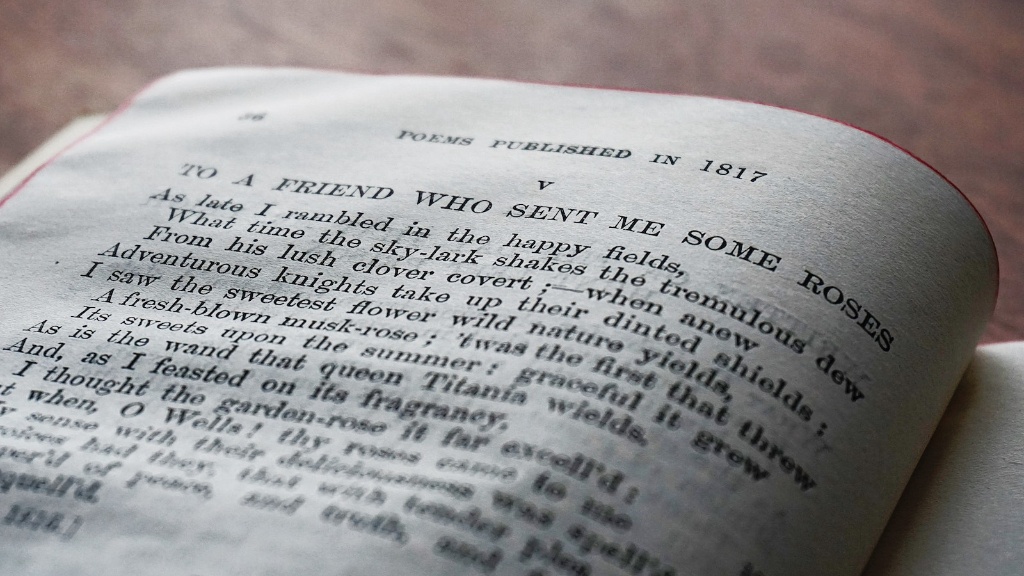Types of Formal Poetry
Formal poetry is verse that follows established conventions of meter, rhyme, and stanzaic form. There is a wide variety of forms of formal poetry that have been used across cultures and throughout history. Some of the most common forms of formal poetry include anapestic verse, haiku, sestinas, and Villanelles.
An anapestic verse is a type of rhyming poem based on a structure of two short syllables followed by one long syllable. The meter of anapestic verse stays consistent throughout the poem. The most famous example of anapestic verse is found Dr. Seuss’s works and consist of a three line stanza where the first two lines contain four beats each, and the last line contains six beats.
Haiku is another type of formal poem consisting of three lines, with a syllable structure of 5-7-5. These poems are usually used to articulate an image in nature, while conveying a certain emotion or sentiment. Often, haiku have a strong sensory elements, emphasizing sight, sound, touch, taste or smell.
A sestina is composed of six stanzas of six lines each. The last words of each line of the first stanza are then repeated in different orders as the last words of lines in each of the following stanzas. The last three lines of the poem are then all end-stopped and use two of the last words from each of the preceding stanzas.
Villanelles are composed of five three-line stanzas and a four-line closing, strongly rhymed and incorporating two lines repeated in a complex pattern throughout the poem. The two repeated lines alternate as the last lines of the first four stanzas, and then finally appear together as the last two lines of the finale.
Forms of Traditional Poetry
In addition to these more recently developed forms of formal poetry, there are also traditional forms of verse found in all cultures. These many forms include, for example Japanese tanka, French rondel, Persian ghazals, and Chinese ci.
Japanese tanka is a traditional poem form composed of five lines containing five, seven, five, seven, and seven syllables respectively. The poem has a strong emphasis on nature and conveys the poet’s emotions and sentiments.
The rondel is a French verse form that consists of two seven-lined stanzas each of which uses two rhymes. The first line of the first stanza is then repeated as a refrain at the end of the second stanza.
The Persian ghazals usually consist of five or more independent couplets that convey a single idea at the end. They employ identical rhyme sounds, but the rhyme can vary in the couplets.
A Chinese ci poem is composed of four or more seven-syllable lines with a particular tone pattern usually linked to the music of songs. A ci poem is usually composed around a single repeating line or phrase.
Formulating the Poem
Formulating a poem that follows one of these formal patterns can be a difficult proposition. It requires the poet to choose language and rhythm that form an idea into a set structure. When producing a formal poem, writers often begin by focusing on the structure and rhyme of the poem as a way to conceptually organize the poem.
Most importantly, using established poetic guidelines gives the poet an opportunity to explore the nuances of their language and illustrate the interplay between meter and sentiment. In this way it gives a writer more control over the expression of the poem, and allows the writer to craft something that has its own unique identity.
The Benefit of Formal Poetry
Formal poetry is beneficial in that it can produce a sense of unity in its readers through the regularity of its form. This is often seen to be expressed in the feeling of its meter which can encompass the emotions that the poem is meant to convey. Furthermore, its rules can help beginners learn the basics of poetry before expanding into freer forms.
Formal poetry also allows poets to explore creative solutions to their verse. Its rules and parameters can push writers to find the most concise and concisely expressed ideas. This can be seen to be particularly true in the structure of the haiku or sestina, where the capping lines often form a perfectly symmetrical and direct summation of the poem’s subject matter.
Continuing a Legacy
Formal poetry has a long and colourful tradition that stretches back to ancient societies and continues today in the works of contemporary poets. It gives writers the opportunity to explore both their language and poetic technique, while creating work that expresses their ideas and emotions in a powerful way.
These types of poems can provide a form wherein the writer can directly transfer their ideas, experiences, and emotions to the reader. Every poem follows a unique structure and meter which conveys the story or image being expressed. This in turn can lead to a shared understanding between reader and writer, as the poem becomes a tool through which these ideas and emotions can be communicated.
Aids to Writing Formal Poetry
While the craft of formal poetry might appear daunting to many, there are helpful tools now available to aid the novice writer. Software tools such as forms of verse generators, rhyming programs and sonnet generating websites can help poets explore their ideas within the formal parameters of a poem.
These tools can help to eliminate some of the difficulty in understanding the underlying structures of a formal poem and can give the poet more confidence in their work. For those more experienced in writing formal verse, these tools offer another level of creativity as it allows them to further tinker with established structures and find new and interesting ways to express their poetry.
Reading Formal Poetry
Reading formal poetry requires an appreciation of its various properties, such as how the language, meter and rhyme interact with each other to create a unique and powerful voice. On a more general level, the read of formal poetry must understand the broader themes and ideas contained within it.
The ability to recognize and appreciate the subtleties and nuances of formal poetry can be a difficult process as there are often several layers of meaning contained in a single work. The read is presented with the challenge of understanding and relating to each individual poem to gain the full benefit of its telling.
Conclusion of Formal Poetry
Ultimately, formal poetry provides poets with a powerful tool of expression. It allows writers to craft stories and emotions by making use of the unique combination of language, meter and rhyme. Through its set parameters, formal verse offers something that most more free forms of verse cannot, a tangible structure around which ideas can be crafted.
At the same time, readers of the genre must approach it with an appreciation of the underlying structure and nuances to be found therein. Through their appreciation of the power of structured and patterned verse, readers will be able to gain a greater understanding of the ideas and emotions found in formal poetry.


